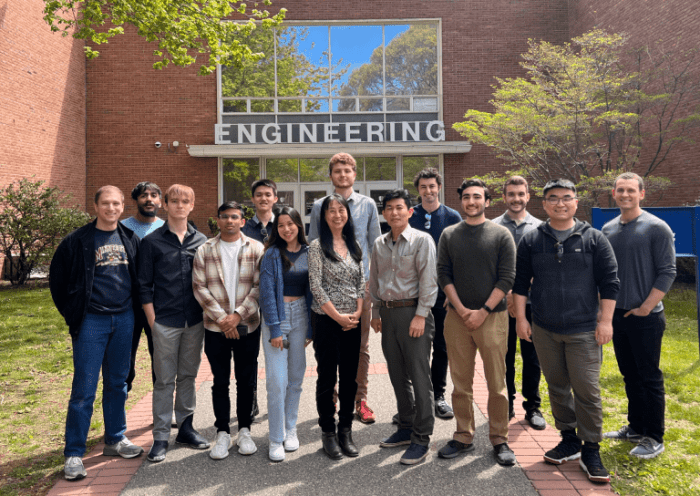SBU couple scores $1.2M to study ways to provide anti pathogen coating

By Daniel Dunaief
Hoping to take a page out of nature’s playbook, a married couple in the Department of Materials Science and Chemical Engineering at Stony Brook University is studying a structure that could prevent the spread of pathogens on the surface.
Before the pandemic started, Research Professor Maya Endoh and Associate Professor Tadanori Koga were exploring how anti microbial coatings controlled pathogens on the molecular scale. With the pandemic, they became more focused on ways to prevent pathogens from causing infections after people came into contact with contaminated surfaces.
Working with researchers from Oak Ridge National Laboratory, North Carolina Agricultural and Technical State University and the University of Tennessee Health Science Center, the team received $12 million over three years as a part of the Department of Energy’s Biopreparedness Research Virtual Experiment initiative, which supports multidisciplinary research efforts designed to strengthen precautionary measures against infectious disease outbreaks. Koga and Endoh received a subcontract of $1.2 million from the Oak Ridge National Laboratory which runs until December 2026.
This kind of study, along with other funded research on the spread of pathogens, could be “important to prevent the next pandemic,” said Endoh. She added that this kind of work could not only help reduce the danger from another potential pandemic, but could also help cut down infections from other common health threats.
The research plans to explore the physical and chemical interactions that occur when bacteria come in contact with a material surface.
To develop surface coatings that might resist the spread of disease-carrying pathogens, Koga and Endoh are turning to an insect that will be even more abundant than usual this year. For the first time since 1803, the 13-year and 17-year cicadas will emerge at the same time.
Koga and Endoh, however, are less focused on their prevalence or their loud noises than they are on their wings, which resist bacteria and may also provide protection against viruses and fungi, as something about their nanostructure disables these pathogens.
“We want to learn from nature,” said Endoh. “As material scientists, we want to mimic this structure.”
Their method of killing bacteria is to facilitate bacterial attachment to nanopattern surfaces. They are targeting surfaces that are constantly and directly exposed to pathogens, such as medical devices, tools and sensors.
Their computational results suggest that a nanopatterned surface can puncture a bacterial outer membrane. These scientists can not specify the time range clearly, which is something they are pursuing with the awarded project.
“We are targeting the surfaces which are constantly and directly exposed to pathogens, such as medical devices, tools and sensors,” Koga and Endoh explained in an email.
Structural defense
The structure of the cicada wings have nanopillars that are about 100 nanometers tall and that are separated by about 100 nanometers from each other. The nanopillars they plan to use have a height of 10 nanometers, a diameter of 50 nanometers and a space between adjacent cylinders of 70 nanometers.
By creating a similar structure with polymers, the Stony Brook scientists will attempt to manufacture materials that provide the same resistance.
They will optimize the geometric parameters of the nanostructure, especially its height and interpillar spacing, to create different nano topographies, including nanopillars, nanowalls, nanospikes and nanodomes.
They are starting their work with the bacteria E. coli and will use computational approaches to optimize surface geometric parameters, bacteria-substrate interactions and bacterial wall stiffness to create a robust structure-guided antimicrobial surface.
They will use polystyrene block polymers and are planning to use different ingredients such as biopolymers. They believe the ingredients can be varied.
According to their recent molecular dynamics simulations mimicking experimental conditions, attractive interactions promote additional membrane attachment, pulling the membrane taut against the pillars and creating tension that ruptures the cell wall. The rupture occurs at the high curvature regions near the edge of the pillars.
Surfaces coated by polymers would likely require periodic coating applications. The scientists treat those polymers with a three-dimensional link to improve the mechanical property. They also apply atomic-thin scale metal layers to make the surface more durable.
In collaboration with Brookhaven National Laboratory, they are trying to determine how to make this kind of pattern with different substances.
“We don’t know what shape is the best [for various pathogens], what size is the best and what spacing is the best,” said Koga.
Benefits of collaboration
Koga and Endoh appreciate the opportunity to collaborate with a range of talented scientists at other institutions.
“Luckily, we have a lot of collaborators,” Endoh said.
Koga and Endoh became a part of a bigger collaboration when they worked with Jan-Michael Carrillo and Bobby Sumpter at Oak Ridge National Laboratory, who started this project.
“This is a nice step, but it’s not the end,” said Koga. The next step is to “create a real material.”
Lifelong collaboration
Koga and Endoh met in their native Japan. Koga is from Kyushu, while Endoh grew up in Sendai, which was the epicenter of the Tōhoku earthquake in 2011, which created the tsunami at the Fukushima nuclear power plant.
They came to the United States when Koga wanted to become a postdoctoral researcher for a two year assignment at Stony Brook. Over 27 years, and four children later, they are still at Stony Brook.
Over the years, Endoh juggled motherhood and a postponed PhD, which she eventually received from Kyoto University.
Koga enjoys watching Japanese players in Major League Baseball and is a fan of Dodgers superstar Shohei Ohtani. A “soccer mom,” Endoh enjoys cooking and playing the violin. The couple hikes in the summer and skis in the winter.
As for their own protective measures during the pandemic, Koga and Endoh regularly washed their hands, although they didn’t use Purell or other special wipes to clean any surfaces.






